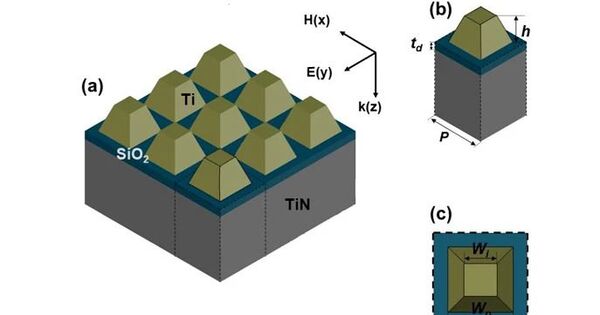A metamaterial absorber is a form of metamaterial designed to effectively absorb electromagnetic radiation, such as light. These intriguing structures are designed to efficiently absorb electromagnetic radiation throughout a specified frequency band. Furthermore, metamaterials represent an advancement in materials science.
They’re made up of intentionally constructed materials, also known as metamaterials, that are intended to control electromagnetic waves in unusual ways. As a result, metamaterials designed to be absorbers outperform traditional absorbers in terms of miniaturization, adaptability, and effectiveness.
Here’s how they typically work:
- Structure: These usually consist of a patterned array of subwavelength structures. These structures are carefully designed to interact with incident electromagnetic waves in a desired manner.
- Tuning: The geometry, arrangement, and composition of the subwavelength structures dictate the absorber’s frequency response. By adjusting these parameters, engineers can tailor the absorber to operate at specific frequencies or over a broad frequency range.
- Efficiency: These can achieve high absorption efficiency, often surpassing traditional absorptive materials like carbon-based coatings or metallic films. This efficiency is due to their ability to exploit resonant effects and control the electromagnetic properties of the material at a very small scale.
Applications
Metamaterial absorbers have applications in a variety of domains, including microwave engineering, infrared imaging, solar energy harvesting, and stealth technologies. For example, in stealth applications, metamaterial absorbers can reduce radar cross-sections by absorbing rather than reflecting incoming radar signals.
The metamaterial absorber is intended for usage as emitters, photodetectors, sensors, spatial light modulators, infrared camouflage, wireless communication, solar photovoltaics, and thermophotovoltaics. For practical applications, metamaterial absorbers are classified into two types: narrowband and broadband. For example, metamaterial absorbers can be utilized to increase photodetectors’ performance.
Challenges
Despite its potential, metamaterial absorbers confront practical implementation issues like as fabrication complexity, limited bandwidth, and sensitivity to incidence angle and polarization. However, continuing research continues to overcome these difficulties in order to realize the full promise of metamaterial-based technologies.
Overall, metamaterial absorbers are a potential way to regulate and manipulate electromagnetic waves, having implications for a wide range of technological advances.
















